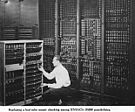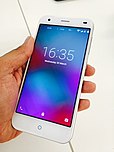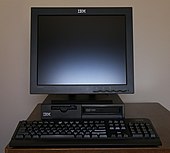Computer
- Early vacuum tube computer (IBM System 360))
- Smartphone (LYF Water 2)
- Desktop computer (IBM ThinkCentre S50 with monitor)
- Video game console (Nintendo GameCube)
- Supercomputer (IBM Summit
A computer is a
A broad range of industrial and consumer products use computers as control systems, including simple special-purpose devices like microwave ovens and remote controls, and factory devices like industrial robots. Computers are at the core of general-purpose devices such as personal computers and mobile devices such as smartphones. Computers power the Internet, which links billions of computers and users.
Early computers were meant to be used only for calculations. Simple manual instruments like the
Conventionally, a modern computer consists of at least one
Etymology
It was not until the mid-20th century that the word acquired its modern definition; according to the
The Online Etymology Dictionary gives the first attested use of computer in the 1640s, meaning 'one who calculates'; this is an "agent noun from compute (v.)". The Online Etymology Dictionary states that the use of the term to mean "'calculating machine' (of any type) is from 1897." The Online Etymology Dictionary indicates that the "modern use" of the term, to mean 'programmable digital electronic computer' dates from "1945 under this name; [in a] theoretical [sense] from 1937, as Turing machine".[3] The name has remained, although modern computers are capable of many higher-level functions.
History
Pre-20th century

Devices have been used to aid computation for thousands of years, mostly using
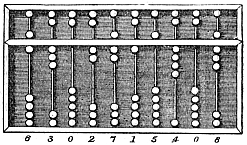
The abacus was initially used for arithmetic tasks. The Roman abacus was developed from devices used in Babylonia as early as 2400 BCE. Since then, many other forms of reckoning boards or tables have been invented. In a medieval European counting house, a checkered cloth would be placed on a table, and markers moved around on it according to certain rules, as an aid to calculating sums of money.[5]
The
Many mechanical aids to calculation and measurement were constructed for astronomical and navigation use. The
The sector, a calculating instrument used for solving problems in proportion, trigonometry, multiplication and division, and for various functions, such as squares and cube roots, was developed in the late 16th century and found application in gunnery, surveying and navigation.
The planimeter was a manual instrument to calculate the area of a closed figure by tracing over it with a mechanical linkage.

The slide rule was invented around 1620–1630 by the English clergyman William Oughtred, shortly after the publication of the concept of the logarithm. It is a hand-operated analog computer for doing multiplication and division. As slide rule development progressed, added scales provided reciprocals, squares and square roots, cubes and cube roots, as well as transcendental functions such as logarithms and exponentials, circular and hyperbolic trigonometry and other functions. Slide rules with special scales are still used for quick performance of routine calculations, such as the E6B circular slide rule used for time and distance calculations on light aircraft.
In the 1770s,
In 1831–1835, mathematician and engineer
The differential analyser, a mechanical analog computer designed to solve differential equations by integration, used wheel-and-disc mechanisms to perform the integration. In 1876, Sir William Thomson had already discussed the possible construction of such calculators, but he had been stymied by the limited output torque of the ball-and-disk integrators.[16] In a differential analyzer, the output of one integrator drove the input of the next integrator, or a graphing output. The torque amplifier was the advance that allowed these machines to work. Starting in the 1920s, Vannevar Bush and others developed mechanical differential analyzers.
In the 1890s, the Spanish engineer Leonardo Torres Quevedo began to develop a series of advanced analog machines that could solve real and complex roots of polynomials,[17][18][19][20] which were published in 1901 by the Paris Academy of Sciences.[21]
First computer

After working on his
The machine was about a century ahead of its time. All the parts for his machine had to be made by hand – this was a major problem for a device with thousands of parts. Eventually, the project was dissolved with the decision of the
Electromechanical calculating machine

In his work Essays on Automatics published in 1914, Leonardo Torres Quevedo wrote a brief history of Babbage's efforts at constructing a mechanical Difference Engine and Analytical Engine. He described the Analytical Engine as exemplifying his theories about the potential power of machines, and takes the problem of designing such an engine as a challenge to his skills as an inventor of electromechanical devices. The paper contains a design of a machine capable of calculating completely automatically the value of the formula , for a sequence of sets of values of the variables involved. The whole machine was to be controlled by a
Analog computers
During the first half of the 20th century, many scientific
The art of mechanical analog computing reached its zenith with the
Digital computers
Electromechanical
By 1938, the United States Navy had developed an electromechanical analog computer small enough to use aboard a submarine. This was the Torpedo Data Computer, which used trigonometry to solve the problem of firing a torpedo at a moving target. During World War II similar devices were developed in other countries as well.

Early digital computers were electromechanical; electric switches drove mechanical relays to perform the calculation. These devices had a low operating speed and were eventually superseded by much faster all-electric computers, originally using vacuum tubes. The Z2, created by German engineer Konrad Zuse in 1939 in Berlin, was one of the earliest examples of an electromechanical relay computer.[34]

In 1941, Zuse followed his earlier machine up with the
Zuse's next computer, the
Vacuum tubes and digital electronic circuits
Purely

During World War II, the British code-breakers at
Colossus was the world's first

The
It combined the high speed of electronics with the ability to be programmed for many complex problems. It could add or subtract 5000 times a second, a thousand times faster than any other machine. It also had modules to multiply, divide, and square root. High speed memory was limited to 20 words (about 80 bytes). Built under the direction of John Mauchly and J. Presper Eckert at the University of Pennsylvania, ENIAC's development and construction lasted from 1943 to full operation at the end of 1945. The machine was huge, weighing 30 tons, using 200 kilowatts of electric power and contained over 18,000 vacuum tubes, 1,500 relays, and hundreds of thousands of resistors, capacitors, and inductors.[56]
Modern computers
Concept of modern computer
The principle of the modern computer was proposed by
Stored programs
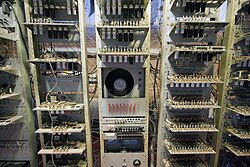
Early computing machines had fixed programs. Changing its function required the re-wiring and re-structuring of the machine.
The
The Mark 1 in turn quickly became the prototype for the
Grace Hopper was the first to develop a compiler for a programming language.[2]
Transistors

The concept of a
At the University of Manchester, a team under the leadership of Tom Kilburn designed and built a machine using the newly developed transistors instead of valves.[68] Their first transistorized computer and the first in the world, was operational by 1953, and a second version was completed there in April 1955. However, the machine did make use of valves to generate its 125 kHz clock waveforms and in the circuitry to read and write on its magnetic drum memory, so it was not the first completely transistorized computer. That distinction goes to the Harwell CADET of 1955,[69] built by the electronics division of the Atomic Energy Research Establishment at Harwell.[69][70]
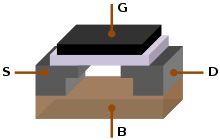
The
Integrated circuits

The next great advance in computing power came with the advent of the integrated circuit (IC). The idea of the integrated circuit was first conceived by a radar scientist working for the Royal Radar Establishment of the Ministry of Defence, Geoffrey W.A. Dummer. Dummer presented the first public description of an integrated circuit at the Symposium on Progress in Quality Electronic Components in Washington, D.C., on 7 May 1952.[82]
The first working ICs were invented by
Noyce also came up with his own idea of an integrated circuit half a year later than Kilby.[89] Noyce's invention was the first true monolithic IC chip.[90][88] His chip solved many practical problems that Kilby's had not. Produced at Fairchild Semiconductor, it was made of silicon, whereas Kilby's chip was made of germanium. Noyce's monolithic IC was fabricated using the planar process, developed by his colleague Jean Hoerni in early 1959. In turn, the planar process was based on Mohamed M. Atalla's work on semiconductor surface passivation by silicon dioxide in the late 1950s.[91][92][93]
Modern monolithic ICs are predominantly MOS (

The development of the MOS integrated circuit led to the invention of the
Mobile computers
The first mobile computers were heavy and ran from mains power. The 50 lb (23 kg) IBM 5100 was an early example. Later portables such as the Osborne 1 and Compaq Portable were considerably lighter but still needed to be plugged in. The first laptops, such as the Grid Compass, removed this requirement by incorporating batteries – and with the continued miniaturization of computing resources and advancements in portable battery life, portable computers grew in popularity in the 2000s.[104] The same developments allowed manufacturers to integrate computing resources into cellular mobile phones by the early 2000s.
These
Types
Computers can be classified in a number of different ways, including:
By architecture
- Analog computer
- Digital computer
- Hybrid computer
- Harvard architecture
- Von Neumann architecture
- Complex instruction set computer
- Reduced instruction set computer
By size, form-factor and purpose
- Supercomputer
- Mainframe computer
- Minicomputer (term no longer used),[106] Midrange computer
- Server
- Personal computer
- Workstation
- Microcomputer (term no longer used)[107]
- Home computer (term fallen into disuse)[108]
- Desktop computer
- Tower desktop
- Slimline desktop
- non-linear editing system computers, video editing PCs and the like, this term is no longer used)[109]
- Gaming computer
- All-in-one PC
- Nettop (Small form factor PCs, Mini PCs)
- Home theater PC
- Keyboard computer
- Portable computer
- Thin client
- Internet appliance
- Laptop
- Desktop replacement computer
- Gaming laptop
- Rugged laptop
- 2-in-1 PC
- Ultrabook
- Chromebook
- Subnotebook
- Smartbook
- Netbook
- Mobile computers:
- Wearable computer
- Single-board computer
- Plug computer
- Stick PC
- Programmable logic controller
- Computer-on-module
- System on module
- System in a package
- System-on-chip(Also known as an Application Processor or AP if it lacks circuitry such as radio circuitry)
- Microcontroller
Hardware
The term hardware covers all of those parts of a computer that are tangible physical objects. Circuits, computer chips, graphic cards, sound cards, memory (RAM), motherboard, displays, power supplies, cables, keyboards, printers and "mice" input devices are all hardware.
History of computing hardware
Other hardware topics
| Peripheral device (input/output) | Input | Mouse, keyboard, joystick, image scanner, webcam, graphics tablet, microphone |
| Output | Monitor, printer, loudspeaker | |
| Both | Floppy disk drive, hard disk drive, optical disc drive, teleprinter | |
| Computer buses | Short range | RS-232, SCSI, PCI, USB |
| Long range (computer networking) | Ethernet, ATM, FDDI |
A general-purpose computer has four main components: the
Input devices
When unprocessed data is sent to the computer with the help of input devices, the data is processed and sent to output devices. The input devices may be hand-operated or automated. The act of processing is mainly regulated by the CPU. Some examples of input devices are:
- Computer keyboard
- Digital camera
- Graphics tablet
- Image scanner
- Joystick
- Microphone
- Mouse
- Overlay keyboard
- Real-time clock
- Trackball
- Touchscreen
- Light pen
Output devices
The means through which computer gives output are known as output devices. Some examples of output devices are:
- Computer monitor
- Printer
- PC speaker
- Projector
- Sound card
- Video card
Control unit

The control unit (often called a control system or central controller) manages the computer's various components; it reads and interprets (decodes) the program instructions, transforming them into control signals that activate other parts of the computer.[d] Control systems in advanced computers may change the order of execution of some instructions to improve performance.
A key component common to all CPUs is the program counter, a special memory cell (a register) that keeps track of which location in memory the next instruction is to be read from.[e]
The control system's function is as follows— this is a simplified description, and some of these steps may be performed concurrently or in a different order depending on the type of CPU:
- Read the code for the next instruction from the cell indicated by the program counter.
- Decode the numerical code for the instruction into a set of commands or signals for each of the other systems.
- Increment the program counter so it points to the next instruction.
- Read whatever data the instruction requires from cells in memory (or perhaps from an input device). The location of this required data is typically stored within the instruction code.
- Provide the necessary data to an ALU or register.
- If the instruction requires an ALU or specialized hardware to complete, instruct the hardware to perform the requested operation.
- Write the result from the ALU back to a memory location or to a register or perhaps an output device.
- Jump back to step (1).
Since the program counter is (conceptually) just another set of memory cells, it can be changed by calculations done in the ALU. Adding 100 to the program counter would cause the next instruction to be read from a place 100 locations further down the program. Instructions that modify the program counter are often known as "jumps" and allow for loops (instructions that are repeated by the computer) and often conditional instruction execution (both examples of control flow).
The sequence of operations that the control unit goes through to process an instruction is in itself like a short computer program, and indeed, in some more complex CPU designs, there is another yet smaller computer called a microsequencer, which runs a microcode program that causes all of these events to happen.
Central processing unit (CPU)
The control unit, ALU, and registers are collectively known as a
Arithmetic logic unit (ALU)
The ALU is capable of performing two classes of operations: arithmetic and logic.
Memory
A computer's memory can be viewed as a list of cells into which numbers can be placed or read. Each cell has a numbered "address" and can store a single number. The computer can be instructed to "put the number 123 into the cell numbered 1357" or to "add the number that is in cell 1357 to the number that is in cell 2468 and put the answer into cell 1595." The information stored in memory may represent practically anything. Letters, numbers, even computer instructions can be placed into memory with equal ease. Since the CPU does not differentiate between different types of information, it is the software's responsibility to give significance to what the memory sees as nothing but a series of numbers.
In almost all modern computers, each memory cell is set up to store binary numbers in groups of eight bits (called a byte). Each byte is able to represent 256 different numbers (28 = 256); either from 0 to 255 or −128 to +127. To store larger numbers, several consecutive bytes may be used (typically, two, four or eight). When negative numbers are required, they are usually stored in two's complement notation. Other arrangements are possible, but are usually not seen outside of specialized applications or historical contexts. A computer can store any kind of information in memory if it can be represented numerically. Modern computers have billions or even trillions of bytes of memory.
The CPU contains a special set of memory cells called registers that can be read and written to much more rapidly than the main memory area. There are typically between two and one hundred registers depending on the type of CPU. Registers are used for the most frequently needed data items to avoid having to access main memory every time data is needed. As data is constantly being worked on, reducing the need to access main memory (which is often slow compared to the ALU and control units) greatly increases the computer's speed.
Computer main memory comes in two principal varieties:
- random-access memory or RAM
- read-only memory or ROM
RAM can be read and written to anytime the CPU commands it, but ROM is preloaded with data and software that never changes, therefore the CPU can only read from it. ROM is typically used to store the computer's initial start-up instructions. In general, the contents of RAM are erased when the power to the computer is turned off, but ROM retains its data indefinitely. In a PC, the ROM contains a specialized program called the BIOS that orchestrates loading the computer's operating system from the hard disk drive into RAM whenever the computer is turned on or reset. In embedded computers, which frequently do not have disk drives, all of the required software may be stored in ROM. Software stored in ROM is often called firmware, because it is notionally more like hardware than software. Flash memory blurs the distinction between ROM and RAM, as it retains its data when turned off but is also rewritable. It is typically much slower than conventional ROM and RAM however, so its use is restricted to applications where high speed is unnecessary.[f]
In more sophisticated computers there may be one or more RAM cache memories, which are slower than registers but faster than main memory. Generally computers with this sort of cache are designed to move frequently needed data into the cache automatically, often without the need for any intervention on the programmer's part.
Input/output (I/O)

I/O is the means by which a computer exchanges information with the outside world.[113] Devices that provide input or output to the computer are called peripherals.[114] On a typical personal computer, peripherals include input devices like the keyboard and mouse, and output devices such as the display and printer. Hard disk drives, floppy disk drives and optical disc drives serve as both input and output devices. Computer networking is another form of I/O. I/O devices are often complex computers in their own right, with their own CPU and memory. A graphics processing unit might contain fifty or more tiny computers that perform the calculations necessary to display 3D graphics.[citation needed] Modern desktop computers contain many smaller computers that assist the main CPU in performing I/O. A 2016-era flat screen display contains its own computer circuitry.
Multitasking
While a computer may be viewed as running one gigantic program stored in its main memory, in some systems it is necessary to give the appearance of running several programs simultaneously. This is achieved by multitasking i.e. having the computer switch rapidly between running each program in turn.[115] One means by which this is done is with a special signal called an interrupt, which can periodically cause the computer to stop executing instructions where it was and do something else instead. By remembering where it was executing prior to the interrupt, the computer can return to that task later. If several programs are running "at the same time". then the interrupt generator might be causing several hundred interrupts per second, causing a program switch each time. Since modern computers typically execute instructions several orders of magnitude faster than human perception, it may appear that many programs are running at the same time even though only one is ever executing in any given instant. This method of multitasking is sometimes termed "time-sharing" since each program is allocated a "slice" of time in turn.[116]
Before the era of inexpensive computers, the principal use for multitasking was to allow many people to share the same computer. Seemingly, multitasking would cause a computer that is switching between several programs to run more slowly, in direct proportion to the number of programs it is running, but most programs spend much of their time waiting for slow input/output devices to complete their tasks. If a program is waiting for the user to click on the mouse or press a key on the keyboard, then it will not take a "time slice" until the event it is waiting for has occurred. This frees up time for other programs to execute so that many programs may be run simultaneously without unacceptable speed loss.
Multiprocessing

Some computers are designed to distribute their work across several CPUs in a multiprocessing configuration, a technique once employed in only large and powerful machines such as
Supercomputers in particular often have highly unique architectures that differ significantly from the basic stored-program architecture and from general-purpose computers.[g] They often feature thousands of CPUs, customized high-speed interconnects, and specialized computing hardware. Such designs tend to be useful for only specialized tasks due to the large scale of program organization required to use most of the available resources at once. Supercomputers usually see usage in large-scale simulation, graphics rendering, and cryptography applications, as well as with other so-called "embarrassingly parallel" tasks.
Software
Software refers to parts of the computer which do not have a material form, such as programs, data, protocols, etc. Software is that part of a computer system that consists of encoded information or computer instructions, in contrast to the physical
Languages
There are thousands of different programming languages—some intended for general purpose, others useful for only highly specialized applications.
| Lists of programming languages | List of programming languages by category, Generational list of programming languages, List of programming languages, Non-English-based programming languages
|
| Commonly used assembly languages | |
| Commonly used high-level programming languages | |
| Commonly used scripting languages | Bourne script, JavaScript, Python, Ruby, PHP, Perl |
Programs
The defining feature of modern computers which distinguishes them from all other machines is that they can be
Stored program architecture
This section applies to most common
In most cases, computer instructions are simple: add one number to another, move some data from one location to another, send a message to some external device, etc. These instructions are read from the computer's
Program execution might be likened to reading a book. While a person will normally read each word and line in sequence, they may at times jump back to an earlier place in the text or skip sections that are not of interest. Similarly, a computer may sometimes go back and repeat the instructions in some section of the program over and over again until some internal condition is met. This is called the flow of control within the program and it is what allows the computer to perform tasks repeatedly without human intervention.
Comparatively, a person using a pocket calculator can perform a basic arithmetic operation such as adding two numbers with just a few button presses. But to add together all of the numbers from 1 to 1,000 would take thousands of button presses and a lot of time, with a near certainty of making a mistake. On the other hand, a computer may be programmed to do this with just a few simple instructions. The following example is written in the MIPS assembly language:
begin:
addi $8, $0, 0 # initialize sum to 0
addi $9, $0, 1 # set first number to add = 1
loop:
slti $10, $9, 1000 # check if the number is less than 1000
beq $10, $0, finish # if odd number is greater than n then exit
add $8, $8, $9 # update sum
addi $9, $9, 1 # get next number
j loop # repeat the summing process
finish:
add $2, $8, $0 # put sum in output register
Once told to run this program, the computer will perform the repetitive addition task without further human intervention. It will almost never make a mistake and a modern PC can complete the task in a fraction of a second.
Machine code
In most computers, individual instructions are stored as machine code with each instruction being given a unique number (its operation code or opcode for short). The command to add two numbers together would have one opcode; the command to multiply them would have a different opcode, and so on. The simplest computers are able to perform any of a handful of different instructions; the more complex computers have several hundred to choose from, each with a unique numerical code. Since the computer's memory is able to store numbers, it can also store the instruction codes. This leads to the important fact that entire programs (which are just lists of these instructions) can be represented as lists of numbers and can themselves be manipulated inside the computer in the same way as numeric data. The fundamental concept of storing programs in the computer's memory alongside the data they operate on is the crux of the von Neumann, or stored program, architecture.[118][119] In some cases, a computer might store some or all of its program in memory that is kept separate from the data it operates on. This is called the Harvard architecture after the Harvard Mark I computer. Modern von Neumann computers display some traits of the Harvard architecture in their designs, such as in CPU caches.
While it is possible to write computer programs as long lists of numbers (machine language) and while this technique was used with many early computers,[h] it is extremely tedious and potentially error-prone to do so in practice, especially for complicated programs. Instead, each basic instruction can be given a short name that is indicative of its function and easy to remember – a mnemonic such as ADD, SUB, MULT or JUMP. These mnemonics are collectively known as a computer's assembly language. Converting programs written in assembly language into something the computer can actually understand (machine language) is usually done by a computer program called an assembler.

Programming language
Programming languages provide various ways of specifying programs for computers to run. Unlike natural languages, programming languages are designed to permit no ambiguity and to be concise. They are purely written languages and are often difficult to read aloud. They are generally either translated into machine code by a compiler or an assembler before being run, or translated directly at run time by an interpreter. Sometimes programs are executed by a hybrid method of the two techniques.
Low-level languages
Machine languages and the assembly languages that represent them (collectively termed low-level programming languages) are generally unique to the particular architecture of a computer's central processing unit (
Historically a significant number of other cpu architectures were created and saw extensive use, notably including the MOS Technology 6502 and 6510 in addition to the Zilog Z80.High-level languages
Although considerably easier than in machine language, writing long programs in assembly language is often difficult and is also error prone. Therefore, most practical programs are written in more abstract high-level programming languages that are able to express the needs of the programmer more conveniently (and thereby help reduce programmer error). High level languages are usually "compiled" into machine language (or sometimes into assembly language and then into machine language) using another computer program called a compiler.[j] High level languages are less related to the workings of the target computer than assembly language, and more related to the language and structure of the problem(s) to be solved by the final program. It is therefore often possible to use different compilers to translate the same high level language program into the machine language of many different types of computer. This is part of the means by which software like video games may be made available for different computer architectures such as personal computers and various video game consoles.
Program design
Program design of small programs is relatively simple and involves the analysis of the problem, collection of inputs, using the programming constructs within languages, devising or using established procedures and algorithms, providing data for output devices and solutions to the problem as applicable.
Bugs
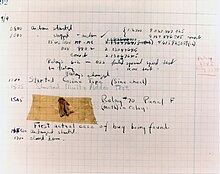
Errors in computer programs are called "bugs". They may be benign and not affect the usefulness of the program, or have only subtle effects. However, in some cases they may cause the program or the entire system to "hang", becoming unresponsive to input such as mouse clicks or keystrokes, to completely fail, or to crash.[126] Otherwise benign bugs may sometimes be harnessed for malicious intent by an unscrupulous user writing an exploit, code designed to take advantage of a bug and disrupt a computer's proper execution. Bugs are usually not the fault of the computer. Since computers merely execute the instructions they are given, bugs are nearly always the result of programmer error or an oversight made in the program's design.[k] Admiral Grace Hopper, an American computer scientist and developer of the first compiler, is credited for having first used the term "bugs" in computing after a dead moth was found shorting a relay in the Harvard Mark II computer in September 1947.[127]
Networking and the Internet
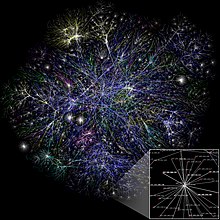
Computers have been used to coordinate information between multiple locations since the 1950s. The U.S. military's
In time, the network spread beyond academic and military institutions and became known as the Internet. The emergence of networking involved a redefinition of the nature and boundaries of the computer. Computer operating systems and applications were modified to include the ability to define and access the resources of other computers on the network, such as peripheral devices, stored information, and the like, as extensions of the resources of an individual computer. Initially these facilities were available primarily to people working in high-tech environments, but in the 1990s the spread of applications like e-mail and the
Unconventional computers
A computer does not need to be
Future
There is active research to make non-classical computers out of many promising new types of technology, such as optical computers, DNA computers, neural computers, and quantum computers. Most computers are universal, and are able to calculate any computable function, and are limited only by their memory capacity and operating speed. However different designs of computers can give very different performance for particular problems; for example quantum computers can potentially break some modern encryption algorithms (by quantum factoring) very quickly.
Computer architecture paradigms
There are many types of computer architectures:
- Quantum computer vs. Chemical computer
- Scalar processor vs. Vector processor
- Non-Uniform Memory Access(NUMA) computers
- Register machine vs. Stack machine
- Harvard architecture vs. von Neumann architecture
- Cellular architecture
Of all these
Artificial intelligence
A computer will solve problems in exactly the way it is programmed to, without regard to efficiency, alternative solutions, possible shortcuts, or possible errors in the code. Computer programs that learn and adapt are part of the emerging field of artificial intelligence and machine learning. Artificial intelligence based products generally fall into two major categories: rule-based systems and pattern recognition systems. Rule-based systems attempt to represent the rules used by human experts and tend to be expensive to develop. Pattern-based systems use data about a problem to generate conclusions. Examples of pattern-based systems include voice recognition, font recognition, translation and the emerging field of on-line marketing.
Professions and organizations
As the use of computers has spread throughout society, there are an increasing number of careers involving computers.
| Hardware-related | Electrical engineering, Electronic engineering, Computer engineering, Telecommunications engineering, Optical engineering, Nanoengineering |
| Software-related |
The need for computers to work well together and to be able to exchange information has spawned the need for many standards organizations, clubs and societies of both a formal and informal nature.
| Standards groups | ANSI, IEC, IEEE, IETF, ISO, W3C |
| Professional societies | ACM, AIS, IET, IFIP, BCS |
open source software groups |
Apache Software Foundation
|
See also
- Computability theory
- Computer security
- Glossary of computer hardware terms
- History of computer science
- List of computer term etymologies
- List of computer system manufacturers
- List of fictional computers
- List of films about computers
- List of pioneers in computer science
- Pulse computation
- TOP500 (list of most powerful computers)
- Unconventional computing
Notes
- ^ According to Schmandt-Besserat 1981, these clay containers contained tokens, the total of which were the count of objects being transferred. The containers thus served as something of a bill of lading or an accounts book. In order to avoid breaking open the containers, first, clay impressions of the tokens were placed on the outside of the containers, for the count; the shapes of the impressions were abstracted into stylized marks; finally, the abstract marks were systematically used as numerals; these numerals were finally formalized as numbers.
Eventually the marks on the outside of the containers were all that were needed to convey the count, and the clay containers evolved into clay tablets with marks for the count. Schmandt-Besserat 1999 estimates it took 4000 years. - ^ The Intel 4004 (1971) die was 12 mm2, composed of 2300 transistors; by comparison, the Pentium Pro was 306 mm2, composed of 5.5 million transistors.[101]
- instruction setarchitectures are extensions of earlier designs. All of the architectures listed in this table, except for Alpha, existed in 32-bit forms before their 64-bit incarnations were introduced.
- ^ The control unit's role in interpreting instructions has varied somewhat in the past. Although the control unit is solely responsible for instruction interpretation in most modern computers, this is not always the case. Some computers have instructions that are partially interpreted by the control unit with further interpretation performed by another device. For example, EDVAC, one of the earliest stored-program computers, used a central control unit that interpreted only four instructions. All of the arithmetic-related instructions were passed on to its arithmetic unit and further decoded there.
- ^ Instructions often occupy more than one memory address, therefore the program counter usually increases by the number of memory locations required to store one instruction.
- ^ Flash memory also may only be rewritten a limited number of times before wearing out, making it less useful for heavy random access usage.[112]
- ^ However, it is also very common to construct supercomputers out of many pieces of cheap commodity hardware; usually individual computers connected by networks. These so-called computer clusters can often provide supercomputer performance at a much lower cost than customized designs. While custom architectures are still used for most of the most powerful supercomputers, there has been a proliferation of cluster computers in recent years.[117]
- ^ Even some later computers were commonly programmed directly in machine code. Some minicomputers like the DEC PDP-8 could be programmed directly from a panel of switches. However, this method was usually used only as part of the booting process. Most modern computers boot entirely automatically by reading a boot program from some non-volatile memory.
- Intel 80486. This contrasts with very early commercial computers, which were often one-of-a-kind and totally incompatible with other computers.
- interpreted rather than compiled. Interpreted languages are translated into machine code on the fly, while running, by another program called an interpreter.
- floating pointdivision operations. This was caused by a flaw in the microprocessor design and resulted in a partial recall of the affected devices.
- ^ According to the Shorter Oxford English Dictionary (6th ed, 2007), the word computer dates back to the mid 17th century, when it referred to "A person who makes calculations; specifically a person employed for this in an observatory etc."
References
- ^ Evans 2018, p. 23.
- ^ a b Smith 2013, p. 6.
- ^ "computer (n.)". Online Etymology Dictionary. Archived from the original on 16 November 2016. Retrieved 19 August 2021.
- sexagesimal number systemwas in use 2350–2000 BCE.
- OCLC 24660570.
- ^ The Antikythera Mechanism Research Project Archived 28 April 2008 at the Wayback Machine, The Antikythera Mechanism Research Project. Retrieved 1 July 2007.
- S2CID 4305761.
- ^ G. Wiet, V. Elisseeff, P. Wolff, J. Naudu (1975). History of Mankind, Vol 3: The Great medieval Civilisations, p. 649. George Allen & Unwin Ltd, UNESCO.
- ^ Fuat Sezgin "Catalogue of the Exhibition of the Institute for the History of Arabic-Islamic Science (at the Johann Wolfgang Goethe University", Frankfurt, Germany) Frankfurt Book Fair 2004, pp. 35 & 38.
- S2CID 33513516.
- JSTOR 1006002.
- .
- Őren, Tuncer (2001). "Advances in Computer and Information Sciences: From Abacus to Holonic Agents" (PDF). Turk J Elec Engin. 9 (1): 63–70. Archived(PDF) from the original on 15 September 2009. Retrieved 21 April 2016.
- Donald Routledge Hill(1985). "Al-Biruni's mechanical calendar", Annals of Science 42, pp. 139–163.
- ^ "The Writer Automaton, Switzerland". chonday.com. 11 July 2013. Archived from the original on 20 February 2015. Retrieved 28 January 2015.
- ^ a b Ray Girvan, "The revealed grace of the mechanism: computing after Babbage" Archived 3 November 2012 at the Wayback Machine, Scientific Computing World, May/June 2003
- ^ Torres, Leonardo (10 October 1895). "Memória sobre las Máquinas Algébricas" (PDF). Revista de Obras Públicas (in Spanish) (28): 217–222.
- ^ Leonardo Torres. Memoria sobre las máquinas algébricas: con un informe de la Real academia de ciencias exactas, fisicas y naturales, Misericordia, 1895.
- ISSN 0094-114X.
- S2CID 247503677.
- ^ Torres Quevedo, Leonardo (1901). "Machines á calculer". Mémoires Présentés par Divers Savants à l'Académie des Scienes de l'Institut de France (in French). XXXII. Impr. nationale (París).
- ISBN 978-0-02-741370-0.
- ^ O'Connor, John J.; Robertson, Edmund F. (1998). "Charles Babbage". MacTutor History of Mathematics archive. School of Mathematics and Statistics, University of St Andrews, Scotland. Archived from the original on 16 June 2006. Retrieved 14 June 2006.
- ^ "Babbage". Online stuff. Science Museum. 19 January 2007. Archived from the original on 7 August 2012. Retrieved 1 August 2012.
- ^ Graham-Cumming, John (23 December 2010). "Let's build Babbage's ultimate mechanical computer". opinion. New Scientist. Archived from the original on 5 August 2012. Retrieved 1 August 2012.
- ^ L. Torres Quevedo. Ensayos sobre Automática – Su definicion. Extension teórica de sus aplicaciones, Revista de la Academia de Ciencias Exacta, Revista 12, pp. 391–418, 1914.
- ^ Torres Quevedo, Leonardo. Automática: Complemento de la Teoría de las Máquinas, (pdf), pp. 575-583, Revista de Obras Públicas, 19 November 1914.
- ISBN 978-3-319-50508-4
- ^ Randell 1982, p. 6, 11–13.
- ^ B. Randell. Electromechanical Calculating Machine, The Origins of Digital Computers, pp.109-120, 1982.
- ^ Bromley 1990.
- ^ Randell, Brian. Digital Computers, History of Origins, (pdf), p. 545, Digital Computers: Origins, Encyclopedia of Computer Science, January 2003.
- ^ a b c d The Modern History of Computing. Stanford Encyclopedia of Philosophy. 2017. Archived from the original on 12 July 2010. Retrieved 7 January 2014.
- ^ Zuse, Horst. "Part 4: Konrad Zuse's Z1 and Z3 Computers". The Life and Work of Konrad Zuse. EPE Online. Archived from the original on 1 June 2008. Retrieved 17 June 2008.
- ^ Bellis, Mary (15 May 2019) [First published 2006 at inventors.about.com/library/weekly/aa050298.htm]. "Biography of Konrad Zuse, Inventor and Programmer of Early Computers". thoughtco.com. Dotdash Meredith. Archived from the original on 13 December 2020. Retrieved 3 February 2021.
Konrad Zuse earned the semiofficial title of 'inventor of the modern computer'[who?]
- ^ "Who is the Father of the Computer?". ComputerHope.
- ISBN 978-3-642-08151-4.
- ^ Salz Trautman, Peggy (20 April 1994). "A Computer Pioneer Rediscovered, 50 Years On". The New York Times. Archived from the original on 4 November 2016. Retrieved 15 February 2017.
- ISBN 978-3-540-56292-4.
- ^ "Crash! The Story of IT: Zuse". Archived from the original on 18 September 2016. Retrieved 1 June 2016.
- S2CID 14606587.
- ^ Rojas, Raúl. "How to Make Zuse's Z3 a Universal Computer" (PDF). fu-berlin.de. Archived (PDF) from the original on 9 August 2017. Retrieved 28 September 2015.
- ^ ISBN 978-3-030-66599-9.
- ^ "notice". Des Moines Register. 15 January 1941.
- ISBN 0-472-08104-7. Retrieved 1 June 2019.
- ^ ISBN 978-0-19-284055-4.
- ^ Miller, Joe (10 November 2014). "The woman who cracked Enigma cyphers". BBC News. Archived from the original on 10 November 2014. Retrieved 14 October 2018.
- ^ Bearne, Suzanne (24 July 2018). "Meet the female codebreakers of Bletchley Park". The Guardian. Archived from the original on 7 February 2019. Retrieved 14 October 2018.
- ^ "Bletchley's code-cracking Colossus". BBC. Archived from the original on 4 February 2010. Retrieved 24 November 2021.
- ^ "Colossus – The Rebuild Story". The National Museum of Computing. Archived from the original on 18 April 2015. Retrieved 7 January 2014.
- ^ Randell, Brian; Fensom, Harry; Milne, Frank A. (15 March 1995). "Obituary: Allen Coombs". The Independent. Archived from the original on 3 February 2012. Retrieved 18 October 2012.
- ^ Fensom, Jim (8 November 2010). "Harry Fensom obituary". The Guardian. Archived from the original on 17 September 2013. Retrieved 17 October 2012.
- Honeywell v. Sperry Rand.
- ^ Evans 2018, p. 39.
- ^ Light 1999, p. 459.
- ^ "Generations of Computer". techiwarehouse.com. Archived from the original on 2 July 2015. Retrieved 7 January 2014.
- S2CID 73712.
- Stanley Frankel to Brian Randell, 1972.
- ISSN 0958-7403. Archived from the originalon 9 January 2012. Retrieved 19 April 2008.
- ISSN 0958-7403. Archived from the originalon 28 August 2017. Retrieved 7 July 2010.
- ^ "Early Electronic Computers (1946–51)". University of Manchester. Archived from the original on 5 January 2009. Retrieved 16 November 2008.
- ^ Napper, R. B. E. "Introduction to the Mark 1". The University of Manchester. Archived from the original on 26 October 2008. Retrieved 4 November 2008.
- ^ "Our Computer Heritage Pilot Study: Deliveries of Ferranti Mark I and Mark I Star computers". Computer Conservation Society. Archived from the original on 11 December 2016. Retrieved 9 January 2010.
- ^ Lavington, Simon. "A brief history of British computers: the first 25 years (1948–1973)". British Computer Society. Archived from the original on 5 July 2010. Retrieved 10 January 2010.
- ISBN 978-1-139-64377-1. Archived from the original(PDF) on 9 December 2019. Retrieved 31 July 2019.
- ISBN 978-3-527-34053-8. Retrieved 31 July 2019.
- ^ ISBN 978-0-470-50892-3. Retrieved 28 August 2019.
- ^ Lavington 1998, pp. 34–35.
- ^ from the original on 8 November 2020. Retrieved 7 June 2009. (subscription required)
- ^ Cooke-Yarborough, E.H. (1957). Introduction to Transistor Circuits. Edinburgh: Oliver and Boyd. p. 139.
- ^ "1960: Metal Oxide Semiconductor (MOS) Transistor Demonstrated". The Silicon Engine: A Timeline of Semiconductors in Computers. Computer History Museum. Archived from the original on 27 October 2019. Retrieved 31 August 2019.
- S2CID 29105721.
- EETimes. Archivedfrom the original on 24 September 2019. Retrieved 18 July 2019.
- ^ Laws, David (4 December 2013). "Who Invented the Transistor?". Computer History Museum. Archived from the original on 13 December 2013. Retrieved 20 July 2019.
- ^ JSTOR 24923169.
- ISBN 978-0-8412-2861-0. Retrieved 28 August 2019.
The relative simplicity and low power requirements of MOSFETs have fostered today's microcomputer revolution.
- ISBN 978-1-107-43449-3. Retrieved 28 August 2019.
- ^ Marriott, J.W. (10 June 2019). "Remarks by Director Iancu at the 2019 International Intellectual Property Conference". United States Patent and Trademark Office. Archived from the original on 17 December 2019. Retrieved 20 July 2019.
- ^ "Dawon Kahng". National Inventors Hall of Fame. Archived from the original on 27 October 2019. Retrieved 27 June 2019.
- ^ "Martin Atalla in Inventors Hall of Fame, 2009". Archived from the original on 19 September 2019. Retrieved 21 June 2013.
- ^ Triumph of the MOS Transistor. Computer History Museum. 6 August 2010. Archived from the original on 18 August 2021. Retrieved 21 July 2019 – via YouTube.
- ^ "The Hapless Tale of Geoffrey Dummer" Archived 11 May 2013 at the Wayback Machine, (n.d.), (HTML), Electronic Product News, accessed 8 July 2008.
- ^ Kilby, Jack (2000). "Nobel lecture" (PDF). Stockholm: Nobel Foundation. Archived (PDF) from the original on 29 May 2008. Retrieved 15 May 2008.
- ^ The Chip that Jack Built Archived 1 May 2015 at the Wayback Machine, (c. 2008), (HTML), Texas Instruments, Retrieved 29 May 2008.
- ^ Jack S. Kilby, Miniaturized Electronic Circuits, United States Patent Office, US Patent 3,138,743, filed 6 February 1959, issued 23 June 1964.
- ISBN 978-0-415-14230-4. Retrieved 6 June 2020.
- ISBN 978-981-281-445-6. Retrieved 28 August 2019.
- ^ a b "Integrated circuits". NASA. Archived from the original on 21 July 2019. Retrieved 13 August 2019.
- Fairchild Semiconductor Corporation.
- ^ "1959: Practical Monolithic Integrated Circuit Concept Patented". Computer History Museum. Archived from the original on 24 October 2019. Retrieved 13 August 2019.
- ISBN 978-3-540-34258-8.
- ISBN 978-0-8018-8639-3. Retrieved 31 July 2019.
- ISBN 978-1-56677-193-1. Retrieved 28 August 2019.
- ^ (PDF) from the original on 29 August 2017. Retrieved 31 July 2019.
- ^ a b "Tortoise of Transistors Wins the Race – CHM Revolution". Computer History Museum. Archived from the original on 10 March 2020. Retrieved 22 July 2019.
- ^ "1964 – First Commercial MOS IC Introduced". Computer History Museum. Archived from the original on 22 December 2015. Retrieved 31 July 2019.
- ^ "1968: Silicon Gate Technology Developed for ICs". Computer History Museum. Archived from the original on 29 July 2020. Retrieved 22 July 2019.
- ^ a b "1971: Microprocessor Integrates CPU Function onto a Single Chip". Computer History Museum. Archived from the original on 12 August 2021. Retrieved 22 July 2019.
- ISBN 978-1-107-05240-6. Retrieved 31 July 2019.
- ^ "Intel's First Microprocessor—the Intel 4004". Intel Corp. November 1971. Archived from the original on 13 May 2008. Retrieved 17 May 2008.
- ISBN 978-1-55860-428-5.
- ^ Federico Faggin, The Making of the First Microprocessor Archived 27 October 2019 at the Wayback Machine, IEEE Solid-State Circuits Magazine, Winter 2009, IEEE Xplore
- ^ a b "7 dazzling smartphone improvements with Qualcomm's Snapdragon 835 chip". 3 January 2017. Archived from the original on 30 September 2019. Retrieved 5 April 2019.
- ^ Chartier, David (23 December 2008). "Global notebook shipments finally overtake desktops". Ars Technica. Archived from the original on 4 July 2017. Retrieved 14 June 2017.
- ^ IDC (25 July 2013). "Growth Accelerates in the Worldwide Mobile Phone and Smartphone Markets in the Second Quarter, According to IDC". Archived from the original on 26 June 2014.
- ^ "Google Books Ngram Viewer". books.google.com.
- ^ "Google Books Ngram Viewer". books.google.com.
- ^ "Google Books Ngram Viewer". books.google.com.
- ^ "Google Books Ngram Viewer". books.google.com.
- ISBN 978-1-56881-128-4.
- ISBN 978-0-8247-4067-2.
- ^ Verma & Mielke 1988.
- ^ Donald Eadie (1968). Introduction to the Basic Computer. Prentice-Hall. p. 12.
- ISBN 978-0-471-05051-3.
- ISBN 978-0-596-00261-9.
- ISBN 978-0-8493-0949-6.
- ^ TOP500 2006, p. [page needed].
- ISBN 978-0-521-65168-4. Archivedfrom the original on 30 July 2022. Retrieved 10 June 2022.
- ISBN 978-981-16-3848-0. Archivedfrom the original on 30 July 2022. Retrieved 10 June 2022.
It is called the stored program architecture or stored program model, also known as the von Neumann architecture. We will use these terms interchangeably.
- ISBN 978-1-4987-0528-8. Retrieved 26 November 2022.
- ISBN 978-0-08-045496-2. Retrieved 26 November 2022.
- ISBN 978-1-4987-0528-8. Retrieved 26 November 2022.
- ISBN 978-1-4665-1821-6. Retrieved 26 November 2022.
- ISBN 978-0-201-00650-6. Retrieved 26 November 2022.
- ISBN 978-0-321-31379-9. Retrieved 26 November 2022.
- ^ "Why do computers crash?". Scientific American. Archived from the original on 1 May 2018. Retrieved 3 March 2022.
- ^ Taylor, Alexander L. III (16 April 1984). "The Wizard Inside the Machine". Time. Archived from the original on 16 March 2007. Retrieved 17 February 2007.
- ISBN 978-0-262-08285-3.
The experience of SAGE helped make possible the first truly large-scale commercial real-time network: the SABRE computerized airline reservations system
- arXiv:cs/9901011.
- ^ "Definition of computer". Thefreedictionary.com. Archived from the original on 26 December 2009. Retrieved 29 January 2012.
- ISBN 978-0-8493-2749-0. Retrieved 9 November 2020.
Sources
- Evans, Claire L. (2018). Broad Band: The Untold Story of the Women Who Made the Internet. New York: Portfolio/Penguin. ISBN 978-0-7352-1175-9. Retrieved 9 November 2020.
- Fuegi, J.; Francis, J. (2003). "Lovelace & Babbage and the creation of the 1843 'notes'". IEEE Annals of the History of Computing. 25 (4): 16. S2CID 40077111.
- Kempf, Karl (1961). Historical Monograph: Electronic Computers Within the Ordnance Corps. Aberdeen Proving Ground (United States Army). Archived from the original on 16 October 2006. Retrieved 24 October 2006.
- Phillips, Tony (2000). "The Antikythera Mechanism I". American Mathematical Society. Archived from the original on 27 April 2006. Retrieved 5 April 2006.
- Shannon, Claude Elwood (1940). A symbolic analysis of relay and switching circuits (Thesis). Massachusetts Institute of Technology. hdl:1721.1/11173.
- Digital Equipment Corporation (1972). PDP-11/40 Processor Handbook (PDF). Maynard, MA: Digital Equipment Corporation. Archived (PDF) from the original on 1 December 2017. Retrieved 27 November 2017.
- Swade, Doron D. (February 1993). "Redeeming Charles Babbage's Mechanical Computer". Scientific American. 268 (2): 86–91. JSTOR 24941379.
- Meuer, Hans; Strohmaier, Erich; Simon, Horst; Dongarra, Jack (13 November 2006). "Architectures Share Over Time". TOP500. Archived from the original on 20 February 2007. Retrieved 27 November 2006.
- Lavington, Simon (1998). A History of Manchester Computers (2nd ed.). Swindon: The British Computer Society. ISBN 978-0-902505-01-8.
- Light, Jennifer S. (1999). "When Computers Were Women". Technology and Culture. 40 (3): 455–483. S2CID 108407884.
- Schmandt-Besserat, Denise (1999). "Tokens: The Cognitive Significance". Documenta Praehistorica. XXVI. Archived from the original on 30 January 2012.
- PMID 17748027.
- Stokes, Jon (2007). Inside the Machine: An Illustrated Introduction to Microprocessors and Computer Architecture. San Francisco: No Starch Press. ISBN 978-1-59327-104-6.
- Zuse, Konrad (1993). The Computer – My life. Berlin: Pringler-Verlag. ISBN 978-0-387-56453-1.
- Felt, Dorr E. (1916). Mechanical arithmetic, or The history of the counting machine. Chicago: Washington Institute.
- Ifrah, Georges (2001). The Universal History of Computing: From the Abacus to the Quantum Computer. New York: John Wiley & Sons. ISBN 978-0-471-39671-0.
- Berkeley, Edmund (1949). Giant Brains, or Machines That Think. John Wiley & Sons.
- Cohen, Bernard (2000). "Howard Aiken, Portrait of a computer pioneer". Physics Today. 53 (3). Cambridge, Massachusetts: The MIT Press: 74–75. ISBN 978-0-262-53179-5.
- Ligonnière, Robert (1987). Préhistoire et Histoire des ordinateurs. Paris: Robert Laffont. ISBN 978-2-221-05261-7.
- Couffignal, Louis (1933). Les machines à calculer; leurs principes, leur évolution. Paris: Gauthier-Villars.
- Essinger, James (2004). Jacquard's Web, How a hand loom led to the birth of the information age. Oxford University Press. ISBN 978-0-19-280577-5.
- ISBN 978-0-691-02377-9.
- Bowden, B. V. (1953). Faster than thought. New York, Toronto, London: Pitman publishing corporation.
- Moseley, Maboth (1964). Irascible Genius, Charles Babbage, inventor. London: Hutchinson.
- Collier, Bruce (1970). The little engine that could've: The calculating machines of Charles Babbage. Garland Publishing. ISBN 978-0-8240-0043-1. Archivedfrom the original on 20 January 2007. Retrieved 24 October 2013.
- Randell, Brian (1982). "From Analytical Engine to Electronic Digital Computer: The Contributions of Ludgate, Torres, and Bush" (PDF). Archived from the original (PDF) on 21 September 2013. Retrieved 29 October 2013.
- Bromley, Allan G. (1990). "Difference and Analytical Engines". In Aspray, William (ed.). Computing Before Computers (PDF). Ames: Iowa State University Press. pp. 59–98. ISBN 978-0-8138-0047-9. Archived(PDF) from the original on 9 October 2022.
- Smith, Erika E. (2013). "Recognizing a Collective Inheritance through the History of Women in Computing". CLCWeb: Comparative Literature and Culture. 15 (1): 1–9. .
- Verma, G.; Mielke, N. (1988). Reliability performance of ETOX based flash memories. IEEE International Reliability Physics Symposium.
External links
 Media related to Computers at Wikimedia Commons
Media related to Computers at Wikimedia Commons Wikiversity has a quiz on this article
Wikiversity has a quiz on this article

